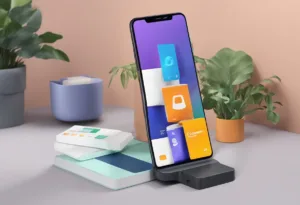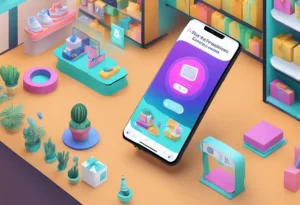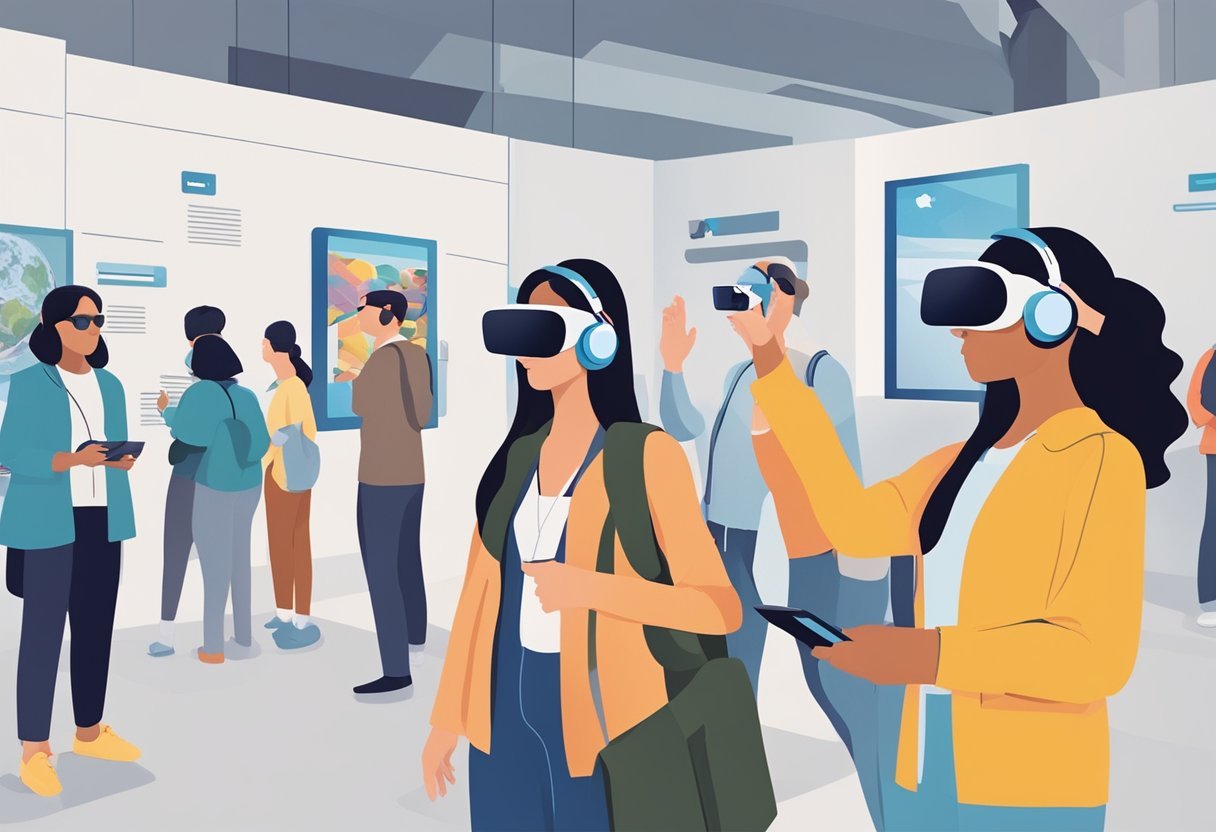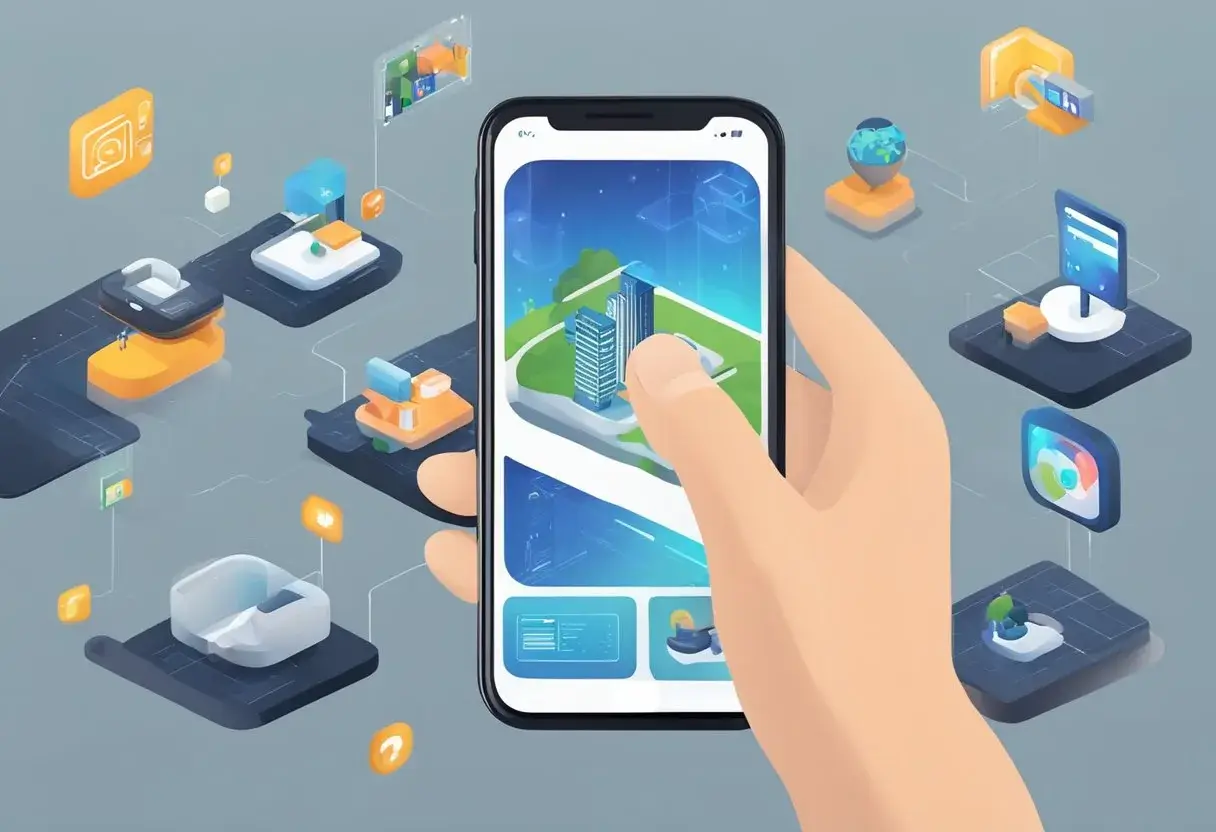Augmented reality (AR) has revolutionized the way businesses market their products and services. It is an interactive technology that overlays digital information over the real world, providing customers with a unique and immersive experience. AR marketing is a creative way to create and distribute virtual content in the physical environment, allowing businesses to connect with their customers in a more engaging and interactive way. In this blog post I will share with you 7 ways to use Augmented reality for marketing and step by step guide to help you get started.
Understanding augmented reality in marketing is crucial for businesses to leverage this technology to its full potential. AR marketing enables businesses to create unique and personalized experiences for their customers, enhancing their brand value and increasing engagement. By using virtual, mixed, and augmented reality (AR) in marketing, businesses can drive deeper and lasting relationships with their customers, opening new doors for bottom-line growth.
Strategic applications of AR in marketing can help businesses stand out from their competition. AR marketing can be used in various industries and categories such as retail, entertainment, education, and healthcare. For instance, it can be used to create interactive product demos, virtual try-ons, and educational experiences.
Key Takeaways
- AR marketing is an interactive technology that overlays digital information over the real world, providing customers with a unique and immersive experience.
- Understanding augmented reality in marketing is crucial for businesses to leverage this technology to its full potential.
- Strategic applications of AR in marketing can help businesses stand out from their competition and create a memorable experience for their customers.
Understanding Augmented Reality in Marketing
Augmented reality (AR) is a technology that overlays digital content onto the real world, creating an interactive experience for users. It has become increasingly popular in marketing over the past few years, with many brands using it to enhance their campaigns and engage with customers in new and exciting ways.
The Evolution of AR Technology
AR technology has come a long way since its inception in the 1960s. The first AR system was developed by Ivan Sutherland at Harvard University, and it consisted of a head-mounted display that projected simple wireframe graphics onto the real world. Since then, AR technology has evolved significantly, with modern systems using advanced computer vision and machine learning algorithms to track and analyze the real world in real-time.
Today, AR technology is widely used in a variety of industries, including gaming, entertainment, education, and marketing. It has become an essential tool for brands looking to create immersive experiences that capture the attention of their target audience.
AR vs. VR: Clarifying the Distinction
While AR and virtual reality (VR) are often used interchangeably, they are two distinct technologies with different use cases. VR is a completely immersive experience that transports users to a virtual world, while AR overlays digital content onto the real world.
In marketing, AR is often used to create interactive experiences that allow customers to try products before they buy them. For example, a makeup brand might use AR to create a virtual makeup try-on experience that allows customers to see how different products would look on their face.
AR is a powerful tool for marketers looking to create engaging and interactive experiences that capture the attention of their target audience. As AR technology continues to evolve, we can expect to see even more innovative uses for it in the future.
How to use Augmented Reality Ideas for marketing

Create an Engaging AR Concept
- Identify your target audience and their interests.
- Develop an AR concept that aligns with your brand message and appeals to your audience.
- Ensure the concept provides value, such as entertainment, information, or a unique experience.
Design the AR Experience
- Sketch the user journey within the AR experience, considering how users will interact with it.
- Create high-quality 3D models and animations that will be used in the AR environment.
- Work with AR developers to build the experience, focusing on user-friendliness and engagement.
Integrate with Marketing Channels
- Decide on the platforms where the AR experience will be available, such as a mobile app or through social media filters.
- Ensure the AR experience is easy to access, possibly through QR codes or direct links.
- Promote the AR experience across all marketing channels, encouraging users to try it.
Test and Iterate
- Conduct user testing to gather feedback on the AR experience.
- Use the feedback to refine and improve the experience, focusing on usability and enjoyment.
- Update the content regularly to keep it fresh and engaging for repeat users.
Launch the Campaign
- Officially launch the AR experience as part of a broader marketing campaign.
- Monitor user engagement and interaction rates to measure success.
- Encourage users to share their AR experience on social media to increase reach.
Measure and Analyze
- Use analytics tools to track how users are interacting with the AR experience.
- Analyze user behavior to understand what works and what doesn’t.
- Use insights gained to optimize the AR experience and future marketing efforts.
Scale and Expand
- Based on the success of the initial AR experience, consider expanding its scope or creating additional experiences.
- Explore new AR features and technologies to enhance future marketing campaigns.
- Continuously look for ways to integrate AR into different aspects of your marketing strategy.
Augmented Reality Ideas for marketing
1. Product Visualization
Augmented Reality (AR) allows customers to visualize products in their own space before making a purchase. For instance, furniture retailers can offer an AR app that enables users to see how a piece of furniture would look in their home. This immersive experience helps in reducing the uncertainty of online shopping and can increase conversion rates by allowing customers to ‘try before they buy. The key steps include creating detailed 3D models of products, developing an intuitive AR app, and ensuring the user experience is seamless.
2. Interactive User Manuals
AR can transform traditional user manuals into interactive guides. By scanning a product with their device, customers can access step-by-step instructions and animations that show how to use or assemble a product. This not only enhances the user experience but also reduces the frustration associated with complex instructions. Companies need to design clear, easy-to-follow AR instructions and ensure they add value beyond what paper manuals offer.
3. Virtual Try-Ons
Fashion and beauty brands can leverage AR for virtual try-ons. Customers can use their smartphone camera to see how clothes, glasses, or makeup products look on them. This interactive shopping experience can be particularly engaging and personalized, encouraging users to make a purchase. Brands must create realistic AR models and integrate them with their e-commerce platforms for a smooth shopping experience.
4. Gamified Marketing Campaigns
Incorporating AR into gamified marketing campaigns can significantly increase engagement. By creating an AR game that aligns with the brand’s image and values, companies can attract and retain customers’ attention. For example, a beverage company might create an AR game where users collect virtual ingredients to make a drink. It’s important for the game to be fun, shareable, and rewarding enough to motivate users to participate.
5. AR-Enabled Advertising
AR-enabled ads can create memorable experiences that stand out in a crowded advertising space. These ads can come to life when viewed through an AR app, displaying animations or additional content. To use AR in advertising effectively, marketers should focus on storytelling and providing value, ensuring that the AR content is relevant and enhances the ad’s message.
6. In-Store Experiences
Retailers can use AR to enhance the in-store experience, offering customers additional information and entertainment as they shop. For instance, pointing an AR app at a product could display reviews, product origins, or suggested pairings. To implement this, retailers need to create engaging AR content and make sure it’s easily accessible within the store, possibly through QR codes or dedicated apps.
7. Event Activation
AR can bring a new dimension to events by offering virtual elements that complement the physical experience. Attendees can interact with AR displays, participate in virtual scavenger hunts, or access exclusive content. Event organizers should ensure the AR elements are relevant to the event’s theme, easy to access, and add value to the overall experience, encouraging social sharing and engagement.
Strategic Applications of AR in Marketing

Augmented Reality (AR) has become an increasingly popular tool for marketers to engage with consumers. By using AR, brands can create interactive experiences that enhance brand engagement, provide virtual try-on and product demos, and launch interactive advertising campaigns.
Enhancing Brand Engagement
AR can be used to create immersive, interactive experiences that enhance brand engagement. By providing consumers with a unique and memorable experience, brands can increase their brand recognition and loyalty. For example, a cosmetics company could use AR to create a virtual makeup try-on experience that allows consumers to see how different products would look on their face. This not only provides a fun and engaging experience for the consumer but also allows them to make more informed purchasing decisions.
Virtual Try-On and Product Demos
AR can also be used to provide virtual try-on and product demos. This allows consumers to see how products would look or function in their own environment before making a purchase. For example, a furniture company could use AR to create a virtual room that allows consumers to place and move furniture around to see how it would look in their own home. This not only provides a more engaging experience for the consumer but also increases the likelihood of a sale.
Interactive Advertising Campaigns
AR can also be used to launch interactive advertising campaigns. By creating unique and interactive experiences, brands can increase their brand awareness and engagement. For example, a car company could use AR to create an interactive ad that allows consumers to see the car in 3D, explore its features, and even take it for a virtual test drive. This not only provides a fun and engaging experience for the consumer but also increases the likelihood of a sale.
AR can be a powerful tool for marketers to enhance brand engagement, provide virtual try-on and product demos, and launch interactive advertising campaigns. By creating unique and memorable experiences, brands can increase their brand recognition and loyalty, while also providing consumers with a more engaging and informative experience.
Case Studies: Successful AR Marketing Campaigns

Augmented reality (AR) has revolutionized the way brands market their products and services. It allows them to create immersive experiences for their customers and engage them in a more interactive way. Here are a few case studies of successful AR marketing campaigns:
IKEA’s Immersive Shopping Experiences
IKEA, a well-known furniture brand, has been using AR to enhance the shopping experience of its customers. Its AR app, IKEA Place, allows customers to visualize how furniture would look in their homes before making a purchase. This has helped IKEA to reduce the number of returns and increase customer satisfaction. The app has been a huge success and has been downloaded over 10 million times.
Sephora and the Beauty Industry Revolution
Sephora, a beauty retailer, has been using AR to revolutionize the way customers try on makeup. Its AR app, Virtual Artist, allows customers to try on different makeup products virtually. This has helped Sephora to increase customer engagement and drive sales. The app has been a huge success and has been downloaded over 8 million times.
Sports and Entertainment: NFL and Pokémon Go
The NFL has been using AR to enhance the fan experience. Its AR app, NFL Helmet Challenge, allows fans to create their own helmet designs and share them on social media. This has helped the NFL to increase fan engagement and drive ticket sales. The app has been a huge success and has been downloaded over 1 million times.
Pokémon Go, a popular mobile game, has been using AR to create an immersive gaming experience. The game allows players to catch virtual Pokémon in the real world using their smartphones. This has helped Pokémon Go to become one of the most popular mobile games of all time, with over 1 billion downloads.
AR has become an essential tool for brands looking to create immersive experiences for their customers. By using AR, brands can increase customer engagement, drive sales, and enhance the overall shopping experience.
AR Marketing Metrics and ROI

Augmented Reality (AR) has become a popular marketing tool for businesses and marketers. AR campaigns can be expensive to produce, and it is essential to measure their effectiveness to determine the return on investment. By tracking engagement, sales, investment, and operational costs, businesses can measure the success of their AR marketing campaigns.
Tracking Engagement and Sales
AR campaigns can help improve engagement and sales. According to a report by Mediapost, users share 61% of AR ads they view, and at Poplar Studio, dwell times on AR ads average at 75 seconds, four times longer than mobile videos. AR campaigns can also result in higher conversion rates, leading to increased sales.
To track engagement and sales, businesses can use various metrics such as click-through rates, conversion rates, and sales revenue. These metrics can help businesses determine the effectiveness of their AR campaigns and make data-driven decisions to improve their marketing strategies.
Investment and Operational Costs
AR campaigns can come with higher production costs than traditional campaigns. It is crucial to determine the return on investment to ensure that these investments are justifiable and yield tangible returns. Businesses can start by setting clear objectives for their AR campaigns and measuring the success of these objectives.
According to a report by Overlyapp, around 50% of businesses that deliver digital marketing activities, including mobile marketing and AR, do so without any strategy or understanding of their ROI. However, a clear understanding of the desired result and the role of AR in achieving this result is essential.
To determine the ROI of AR campaigns, businesses can calculate the investment and operational costs and compare them to the revenue generated from the campaign. This calculation can help businesses determine the effectiveness of their AR campaigns and make informed decisions about future investments.
Tracking engagement, sales, investment, and operational costs can help businesses measure the success of their AR marketing campaigns. By using data-driven metrics and setting clear objectives, businesses can make informed decisions about their marketing strategies and improve their ROI.
Challenges and Considerations in AR Marketing
Augmented Reality (AR) has become an increasingly popular technology in marketing. However, there are still several challenges and considerations that marketers must take into account before implementing AR in their campaigns.
Technological Barriers and Solutions
One of the main challenges of AR technology is the lack of standardization. There are different AR platforms, each with their own set of features and capabilities. This makes it difficult for marketers to create AR experiences that work seamlessly across different devices and platforms.
To overcome this challenge, marketers must ensure that their AR experiences are compatible with a wide range of devices and platforms. They can also consider using AR development tools that support multiple platforms or collaborating with AR development experts who have experience with different platforms.
Another technological barrier is the high cost of AR development. Developing AR experiences requires specialized skills and tools, which can be expensive. AR experiences may require additional hardware, such as AR-enabled devices or sensors, which can add to the cost. To address this challenge, marketers can consider using AR development tools that are more affordable or collaborating with AR development experts who can provide cost-effective solutions.
Consumer Privacy and Ethical Concerns
As with any technology that collects data, AR raises concerns about consumer privacy. AR experiences may collect data about users, such as their location or browsing history, which can be used for targeted advertising. To address these concerns, marketers must be transparent about the data they collect and how it will be used. They must also obtain consent from users before collecting any data and ensure that they comply with relevant privacy laws and regulations.
Another ethical concern is the potential for AR experiences to be used in a manipulative or deceptive way. For example, AR experiences could be used to create false or misleading advertisements or to manipulate users’ perceptions of reality. To address these concerns, marketers must ensure that their AR experiences are truthful and accurate. They must also ensure that their AR experiences do not harm users or promote unethical behavior.
While AR technology offers many benefits for marketing, there are still several challenges and considerations that marketers must take into account. By addressing these challenges and considering ethical concerns, marketers can create successful and effective AR campaigns that engage and delight users.
Frequently Asked Questions
How are companies integrating augmented reality into their marketing strategies?
Companies are integrating augmented reality into their marketing strategies by creating innovative and interactive experiences for their customers. They are leveraging AR technology to create immersive campaigns that engage customers and enhance their brand experience. Augmented reality allows companies to showcase their products and services in a unique way, providing customers with a more personalized and memorable experience.
What are some successful examples of augmented reality in digital marketing?
There are several successful examples of augmented reality in digital marketing. For instance, IKEA’s AR app allows customers to visualize how furniture would look in their homes before making a purchase. The “Lego AR Studio” app is another example of successful AR marketing, allowing customers to bring their Lego creations to life through AR technology. These examples demonstrate how AR can be used to create engaging and interactive experiences for customers.
What are the primary benefits of utilizing augmented reality for marketing purposes?
The primary benefits of utilizing augmented reality for marketing purposes are increased engagement, enhanced customer experience, and improved brand recognition. AR technology allows companies to create unique and immersive experiences that capture the attention of customers and leave a lasting impression. These experiences can help build brand loyalty and increase customer retention rates.
Which augmented reality applications are most effective for marketing campaigns?
The most effective augmented reality applications for marketing campaigns are those that provide customers with an interactive and immersive experience. AR applications that allow customers to visualize products in their own environment or provide them with a unique and entertaining experience are particularly effective. Examples include AR games, virtual try-on experiences, and interactive product demonstrations.
How does augmented reality enhance customer engagement in marketing?
Augmented reality enhances customer engagement in marketing by providing customers with a more interactive and personalized experience. AR technology allows customers to interact with products in a way that is not possible with traditional marketing methods. This increased engagement can lead to greater customer satisfaction, increased brand loyalty, and improved sales.
What trends are emerging in the use of augmented reality by marketing professionals?
Marketing professionals are increasingly using augmented reality to create unique and memorable experiences for customers. One emerging trend is the use of AR in social media marketing, with platforms like Instagram and Snapchat offering AR filters and effects for users. The use of AR in event marketing is becoming more prevalent, with companies using AR technology to create interactive and engaging experiences for attendees.




